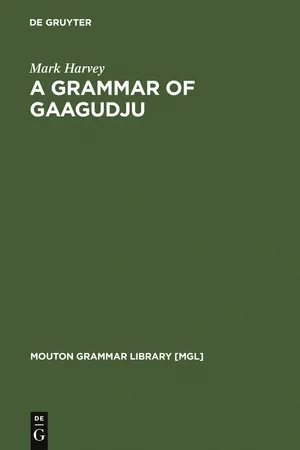A Grammar of Gaagudju
About this book
Gaagudju is a previously undescribed and now nearly extinct language of northern Australia. This grammar provides an overall description of the language. Australian languages generally show a high degree of structural similarity to one another. Gaagudju conforms to some of the common Australian patterns, yet diverges significantly from others. Thus while it has a standard Australian phonological inventory, its prosodic systems differ from those of most Australian languages, with stressed and unstressed syllables showing marked differences in realisation.
Like many northern languages, it has complex systems of both prefixation and suffixation to nominals and verbs. Prefixation provides information about nominal classification (4 classes), mood, and pronominal cross-reference (Subjects, Objects, and Indirect Objects). Suffixation provides information about case, tense, and aspect. As in many languages, there is a clear distinction between productive and unproductive morphology. Gaagudju differs from most Australian languages in that a considerable amount of its morphology is unproductive, showing complex and irregular allomorphic variation.
Gaagudju is like most Australian languages in that it may be described as a free word order language. However, word order is not totally free and strictly ordered phrasal compounding structures are significant (e.g. in the formation of denominal verbs).
Frequently asked questions
- Essential is ideal for learners and professionals who enjoy exploring a wide range of subjects. Access the Essential Library with 800,000+ trusted titles and best-sellers across business, personal growth, and the humanities. Includes unlimited reading time and Standard Read Aloud voice.
- Complete: Perfect for advanced learners and researchers needing full, unrestricted access. Unlock 1.4M+ books across hundreds of subjects, including academic and specialized titles. The Complete Plan also includes advanced features like Premium Read Aloud and Research Assistant.
Please note we cannot support devices running on iOS 13 and Android 7 or earlier. Learn more about using the app.
Information
Table of contents
- Acknowledgements
- List of Tables, Figures and Maps
- Abbreviations
- 1 Language owners and speakers
- 1.1 Location and contact history of Gaagudju language owners and speakers
- 1.2 Previous work
- 1.3 Consultants
- 1.4 Languages spoken in the area
- 1.5 Linguistics relationships of Gaagudju
- 2 Segmental phonology
- 2.1 Phonemic inventory and orthography
- 2.3 Consonantal variation and contrasts
- 2.4 Vocalic variation and contrasts
- 2.5 Intonation
- 2.6 Placement and history of stress
- 2.7 Realisation patterns of the long vowels
- 2.8 Realisation patterns of short vowels
- 2.9 Overview and history of vowel realisations
- 2.10 Reduction of unstressed syllables at word boundaries
- 3 Phonotactics and morphophonology
- 3.1 Affixation, clisis, and phonological words
- 3.2 Syllable structures
- 3.3 Morpheme initial and final segments
- 3.4 Morpheme-medial consonant clusters and intervocalic onsets
- 3.5 Inter-morphemic biconsonantal clusters
- 3.6 Homorganic nasal-stop clusters
- 3.7 Triconsonantal clusters
- 4 Nominals
- 4.1 Parts of speech
- 4.2 Nominal parts-of-speech
- 4.3 Nominal compounding and derivation
- 4.4 Nominal reduplication
- 4.5 Adjectives and gender marked nouns
- 4.6 Noun class membership
- 4.7 Agreement superclassing
- 4.8 Personal pronouns
- 4.9 Kin nouns and kinship terminology
- 4.10 Demonstratives
- 4.11 The history of noun class marking
- 4.12 Locationals
- 4.13 Temporals
- 5 Verbs
- 5.1 Verbal predicate structures
- 5.2 The verbal complex
- 5.3 Compound verbs
- 5.4 Unproductive phrasal verbs
- 5.5 The prefix complex
- 5.6 The directional prefixes
- 5.7 Pronominal prefixes
- 5.8 Conjugational groupings
- 5.9 Tense, aspect, and mood categories
- 5.10 Hortative
- 5.11 Positive imperative
- 6 Clitics and phrasal compounds
- 6.1 Clitics
- 6.2 Argument marking
- 6.3 Indirect object clitics
- 6.4 Dative and locative clitics
- 6.5 Quantification
- 6.6 The ordering of clitics
- 6.7 Phrasal compound structures
- 6.8 Part-whole relationships
- 7 Syntax
- 7.1 Word order, proposition classes and clause types
- 7.2 The noun phrase
- 7.3 Negation
- 7.4 Grammatical relations
- 7.5 Lexicalised cross-reference patterns
- 7.6 Transitivity
- 7.7 Detransitivisation
- 7.8 Causatives
- 7.9 Ascriptive, equational and existential propositions
- 7.10 Possessive propositions
- 7.11 Interclausal Relations
- 7.12 Particles
- Appendices
- 1 Nominals and particles: Gaagudju – English
- 2 Verbs: Gaagudju – English
- 3 English – Gaagudju finderlist for nominals and particles
- 4 English – Gaagudju finderlist for verbs
- 5 Mandanenj gerramaana, the crying orphan story
- References
- Author index
- Land and language index
- Subject index
